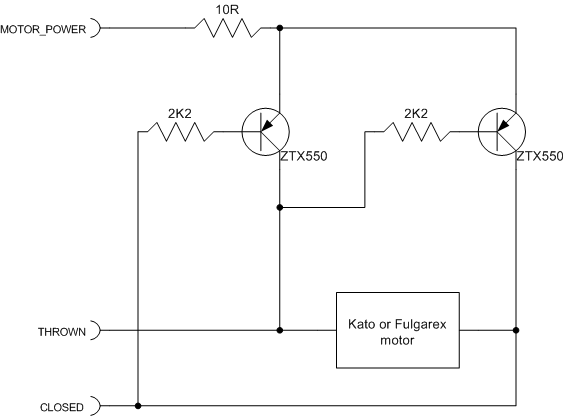A simple output adaptor is required. This allows the output to drive at high current to 12-16v, and at high current to ground. This can be purchased from Sig-naTrak® as a bank of four to fit directly onto the DAC20's SK2 port or alternatively, can be manufactured using prototype board to the below diagram.

For Cobalt IP or Fulgarex type motors:
- any PNP transistor will do; a BC212 should be OK, for example.
- Use the 10ohm series resistor as marked.
- Set the accessory jumper (JP1-JP8) to pins 1-2 (i.e. not capacitor discharge) for the chosen port(s)
- Set the Output to be continuously powered.
For Kato point motors:
- The transistor needs to be able to have a peak collector current of 1A and a gain of at least 100.
- Do NOT use the 10ohm series resistor - wire directly to the transistors
- Set the accessory jumper (JP1-JP8) to pins 2-3 (i.e. capacitor discharge) for the chosen port(s).
- Set the output to solenoid type point motor, 0.25s
For the DAC20 Motor_Power comes from the middle of the three connectors for each output.
Programming for Kato
Kato motors are solenoids. To travel to one end the power is pulsed in one direction; to travel to the reverse direction the power is reversed. To achieve this, program the relevant output control CV (CV11-18, depending on the output required) to 2.
Programming for Cobalt IP or Fulgarex
Cobalt IP or Fulgarex motors require continuous power. To travel to one end the power is applied in one direction; to travel to the reverse direction the power is reversed. To achieve this, program the relevant output control CV (CV11-18 depending on the output required) to 10.
Testing
A good way to test the adaptor is to use a small incandescent lamp (such as you might use to light a building on a model railway). This should light up when the output is operated; if it doesn't light up, the adaptor isn't providing power. For Cobalt or Fulgarex type programmed outputs, the lamp should be on with the output set in either direction. For outputs configured for Kato, the lamp should lamp momentarily when the output is operated in either direction.


